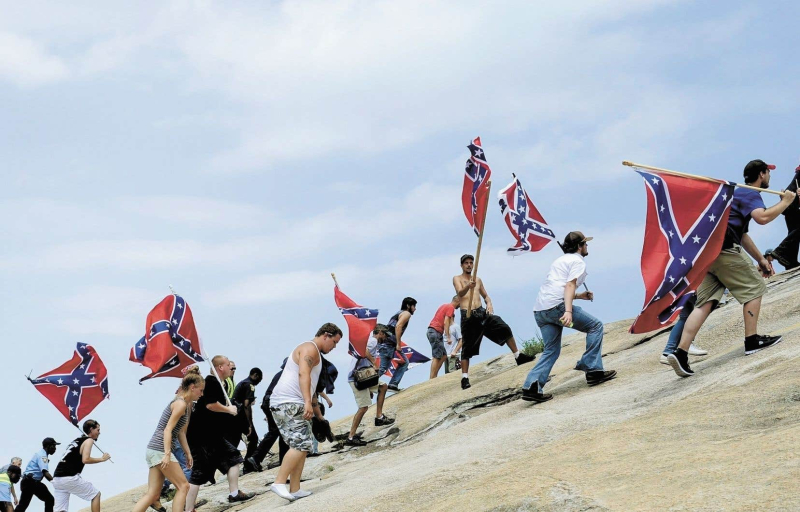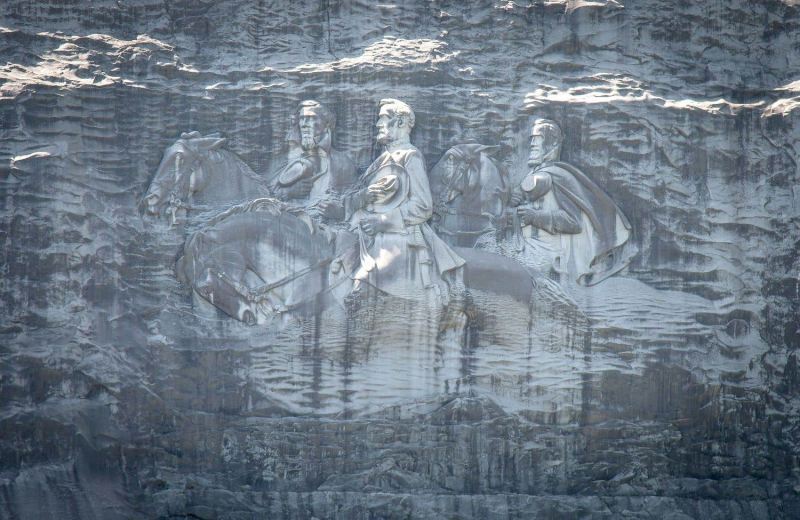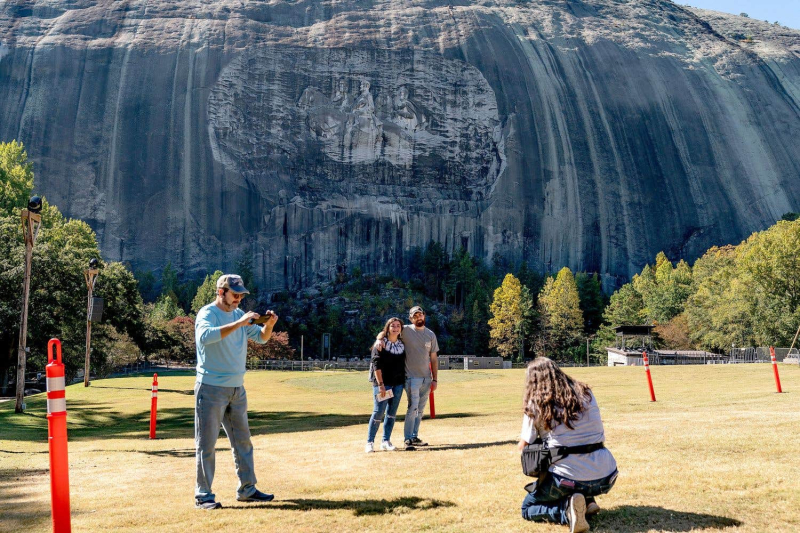
Photo: John Amis Archives The Canadian Press Supporters of the Confederate flag climbed Stone Mountain in August 2015 to protest those who wanted the sculpture destroyed, two months after the Charleston church shooting that left nine people dead.
Sébastien Tanguay at Stone Mountain
Published at 0:00
- United States
Stone Mountain State Park, just outside Atlanta, is not only Georgia's busiest tourist attraction: it's also one of its most controversial. Every year it welcomes a diverse crowd — often families, but sometimes white supremacists and others nostalgic for the Ku Klux Klan, attracted by this place which commemorates the Confederate States of America with a lot of euphemisms.
Behind its good-natured facade made of a dinosaur enclosure, a mini golf course and countless ice cream stands, many see Stone Mountain Park as a sanctuary of assumed racism which peddles a vision of the Civil War imbued with romanticism and historical shortcuts.
Because here, the leaders of the Confederacy are not rebels who took up arms to defend slavery: they are “heroes” who sacrificed their lives in defense of the “freedom” and “values” of the South . The Confederate insurrection was also not an uprising against the abolitionism of Abraham Lincoln's government: it was an operation of self-defense against an “aggression” orchestrated by the North.
“Apologia for racism”
“If you read the explanatory signs scattered throughout the park, you will not find any mention of slavery,” laments Sally Stanhope, member of the Stone Mountain Action Coalition (SMAC), a group which denounces this protected and financed glorification of the southern camp. by the state. “The park is officially a memorial to the Confederacy, but in reality, it mainly promotes its racist ideology. »
Stone Mountain's past fuels this disastrous reputation. One night in 1915, it was at the top of the granite hill located in the heart of the park that the modern KKK burned crosses in a brilliant display that announced its resurrection.
It is also here, engraved on the side of this same hill, that the largest monument in honor of the Confederation in the world is located. It is a colossal representation, sculpted from granite, of the southern troika. President Jefferson Davis and his two most famous generals, Robert E. Lee and Thomas “Stonewall” Jackson, appear in bas-relief in chivalrous poses that evoke righteousness, bravery and heroism.

Photo: Ron Harris Archives Associated Press Jefferson Davis, Robert E. Lee, and Thomas “Stonewall” Jackson appear on the Stone Mountain hillside monument.
The monument is 30m high and covers an area equivalent to 60 tennis courts. The large families have fun posing, all smiles, in front of this engraving which many consider offensive and which constitutes a rallying point for the American extreme right.
“It’s a park owned by Georgia, funded by all the people of Georgia and protected by Georgia law,” recalls Sally Stanhope. “The world’s largest Confederate symbol doesn’t belong there, and it needs to go — or at the very least cease to be maintained with public funds. People who come to walk here don't have to confront the Confederacy and the fact that the state celebrates a nation that defended slavery. »
A past closely linked to the KKK
If Stone Mountain hosts the most great Confederate monument in the world, it is not because the echo of the Civil War resonated at the foot of its mountain. No battle took place here. No illustrious figure of the American Civil War had the surrounding area as their cradle either.
“This engraving was originally the idea of Helen Plane, the widow of a Confederate soldier who was also a member of the United Daughters of the Confederacy,” explains Claire Haley, historian at the Atlanta History Center. “This is a lady who expressed a certain admiration for the Ku Klux Klan: she had even considered, at the beginning, including figures from the KKK alongside figures from the Confederacy. »
The inauguration of this monument, designed at the dawn of the 1910s and partly carved by the sculptor behind Mount Rushmore, did not take place until in 1972 — eight years after the enactment of the Civil Rights Act. It took the leadership of Marvin Griffin, an openly segregationist Georgia politician, to complete the project, which had become fragile due to the Great Depression and the emergence of the American civil rights movement.
In 1954, less than two months after the U.S. Supreme Court's famous ruling in favor of racial diversity in schools, Marvin Griffin, then a candidate for governor, promised to complete the monument in the name of the “Southern way of life.” — a polite way, according to Claire Haley, “to defend racial segregation.” A few months later, he won his elections hands down.
Stone Mountain has since symbolized the resistance of the “ Deep South” in the face of the emergence of civil rights. To the point where even Martin Luther King Jr. mentioned it in his famous 1963 I Have a Dream speech, when he dreamed that “freedom could ring from Stone Mountain, Georgia.”
Supremacist stomping ground
Even today, small far-right groups hold annual meetings at Stone Mountain. The Sons of the Confederate Veterans, for example, an organization exclusively reserved for the male descendants of Southern soldiers, holds a large rally every year in the shadow of the bas-relief.
With their outspoken racist ideology and their Confederate flags in full view, its members gather at Stone Mountain to listen to “distinguished” speakers, such as Pastor John Weaver, presented by the Southern Poverty Law Center as “a pillar of 'a hateful neo-Confederate movement known for advocating secession, slavery, and segregation in the South.'
“Thank goodness park managers refused the Ku Klux Klan’s request to burn crosses on Stone Mountain in 2017,” says SMAC’s Sally Stanhope. “On the other hand, the park must stop tolerating the arrival of supremacist groups. We are simply asking that Stone Mountain become inclusive for everyone. »

Photo: Elijah Nouvelage Archives Agence France-Presse Visitors posed at Stone Mountain Park in front of the Southern Troika, sculpted from granite, in October 2022.
Debate rages over the fate of Confederate imagery inside the park. Some, like the managers of Stone Mountain to whom Le Devoir unsuccessfully attempted to speak, defend the status quo. Others, like Democratic politician Stacey Abrams, are demanding the outright destruction of the monumental bas-relief.
Easier said than done, however. It would probably take years — and a lot of dynamite — to remove a piece of granite of this size. Additionally, Georgia law requires “its preservation and protection until the end of time” in the name of “the bravery and heroism of the people who suffered and died for their cause.”
State law goes so far as to require the Stone Mountain gift shop to carry charms bearing the image of the southern camp in its displays that even Amazon, Walmart and eBay removed from their catalog in the wake of a racial shooting at a Charleston church in 2015.
“The Georgia Congress is currently considering a Democratic bill, which proposes to remove any reference to the “Lost Cause,” the theory that the South fought not to preserve slavery, but in the name of noble, romantic ideals,” says Sally Stanhope. “This is major, because it signals, at least, that in this Congress, there are elected officials who believe that the men responsible for the deaths of millions of Americans during the Civil War are not heroes. Even if our law here says the opposite. »
This report was financed thanks to the Transat International Journalism Fund-Le Devoir.

